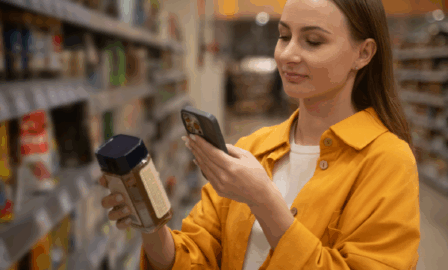Leveraging Generative AI to Create Personalized Products
With rising prices and economic uncertainty on the horizon, consumers are increasingly more discerning with their purchases, leading consumer packaged goods (CPG) companies to reevaluate their value proposition. One of the avenues where CPGs can resonate with customers is through personalization. The advent of Generative AI (GenAI) has taken personalization to new heights, allowing for the creation of truly unique products and packaging. From text-to-image generation to interactive product customization experiences, GenAI enables scalable creativity at a level not previously possible. However, as with any technological innovation, the effective use of GenAI depends on proper regulation and committed oversight. For personalized CPG applications to succeed, GenAI must be supported by high-quality data, strong data privacy measures, and continuous human management. Below we will explore several use cases where CPG companies are effectively leveraging generative AI to create personalized products.
In Practice:
Use Case #1: L’Oréal
L’Oreal has long been at the forefront of beauty tech, especially as it relates to personalization. In 2020, L’Oréal launched the Skin Genuis skin analysis tool – an online platform where customers can take a picture or upload a selfie to receive a personalized skincare routine. The platform utilizes AI to look at 8 attributes of a user’s skin and compares it to over 10,000 clinical graded images to offer a specific personalized routine. From its original release, L’Oréal has continued to grow in their personalized products offerings. Growing from a web-based browser, L’Oréal launched a handheld product, My Hair [iD] Hair Reader, in late 2024. The small device leverages AI to recommend a personalized hair color based on color, grey percentage, and hair fiber diameter and density. Both products have been a huge success, and L’Oréal pledges to continue to grow in their personalized offerings.
Learnings from L’Oreal:
While these products have largely been well received, the use of AI in these use cases poses several unique challenges. First, AI is only as good as its data sources. The ability to produce good quality recommendations hinges on L’Oréal’s ability to supply its AI with high quality, accurate, and well-governed data. L’Oréal reports the initial skin analyzer app was a process that took well over two years and involved over 15,000 skin images analyzed by dermatologists and 600,000 photos analyzed by researchers. This alone proves that the success of L’Oréal’s tools is due to the time and work they put into training their AI models. Additionally, the tool was tested nearly 30,000 times on individuals of various ages and ethnicities to ensure inclusivity and effectiveness. This diverse dataset was a key driver in building both accuracy and trust among users.
While Skin Genius leverages classical AI and computer vision, L’Oréal is now exploring the use of multimodal GenAI to generate personalized skincare narratives, simulate routine outcomes, or even co-create future products with users. This in turn creates a challenge as there is a fine line between personalization and privacy intrusion.
Data privacy is of the utmost importance when utilizing AI in personalization, and companies must ensure they have robust policies in place to protect their users. This can include a robust data privacy policy, regular data audits, or even investing in data security technology. L’Oréal understood the importance of ensuring users’ data security when dealing with sensitive data, and they clearly outline what data they collect, where they store it, and the measures they take to protect it. This goes to show that as companies grow in their personalization, they must also grow in their ability to maintain and govern their data sources.
Use Case #2: Gatorade
Gatorade is among the many companies who have turned to personalized packaging to further connect with their customers. In October of 2024, Gatorade launched a Gen AI powered design experience on their online free membership platform, Gatorade iD. Customers are now able to personalize squeeze bottles by inputting one to three words and choose their preferred colors; in turn, they receive a wholly customized bottle design. The design is powered by Adobe Firefly. According to Xavi Cortadellas, Gatorade’s Senior Director of Marketing and Athletic Equipment, the campaign “puts creative self-expression directly in the athlete’s hands.”
The personalized bottles have been a resounding success. Since the launch, Gatorade reported that they have seen average sales of personalized squeeze bottles increase over 137%, and the average daily Gatorade iD signup increase over 30%.
Learnings from Gatorade:
Just as with L’Oréal, Gatorade had to properly harness the power of AI for this new offering. While they aimed to give customers the opportunity for self-expression, they also needed to ensure brand consistency across designs and prevent inappropriate or offensive content. To achieve this, Gatorade turned to Adobe Firefly, which is trained on Adobe Stock Images and openly licensed content. They further trained the AI only on brand-consistent assets. In close collaboration with Adobe, the brand fine-tuned Firefly’s prompts and generation settings to ensure that outputs adhered to strict visual identity standards. Inappropriate language, symbols, or imagery were filtered through automated prompt moderation and post-processing checks, preserving brand integrity while supporting creative expression.
This thoughtful approach shows how vendor selection, prompt design, content filters, and curation pipelines play a central role in successfully deploying GenAI in consumer-facing applications.
Use Case #3: Johnnie Walker
Like Gatorade, whisky brand Johnnie Walker has also turned to personalized packaging to further create a unique experience for consumers. In August of 2024, Johnnie Walker unveiled their new AI powered experience in Johnnie Walker x Scott Naismith. The iconic whisky brand invited customers to visit their store in Princes Street in Edinburgh, Scotland, to create their very own one-of-a-kind labels for Johnnie Walker Blue Label whisky. Visitors could co-design personalized labels in the style of Scottish artist Scott Naismith by answering three short prompts, where GenAI would then create a label using Amazon’s Bedrock services. Global Breakthrough Innovation Director at Diageo (Walker’s parent company) stated the initiative was successful, “because it offered something different; they felt like they were purchasing more than just a bottle; it was like buying a piece of art.”
Learnings from Johnnie Walker:
The use of AI to generate art in Naismith’s style posed a broader ethical concern for Johnnie Walker. The company emphasized its commitment to protecting the integrity of Naismith’s work while still enabling consumers to create personalized designs by leveraging Amazon’s Titan Bedrock model. Through direct collaboration and training with the artist, Johnnie Walker was able to build upon his artistic style rather than diminish it. The AI model likely used a form of style-conditioned generation—learning patterns from Naismith’s visual works and adapting user prompts into outputs that preserved his unique color palette and techniques. Importantly, the process included Naismith’s full approval and ongoing collaboration, ensuring his creative vision was honored and not replicated without consent.
This case illustrates the growing need for ethical frameworks in GenAI that protect artists while still empowering brands to deliver co-creative consumer experiences.
Going Forward
In sum, mass marketing and generic offerings have lost their appeal, especially to younger consumers, as people are increasingly looking to buy products that feel tailored to them. A study by Epsilon found that 80% of consumers are more likely to purchase from brands that offer personalized experiences. By leveraging GenAI, personalized products can be produced in larger quantities and with greater customization than ever before. However, the use of GenAI must be well governed, as data quality, privacy, and ethical considerations are paramount for the success of GenAI.
Looking ahead, GenAI is likely to evolve into more interactive experiences, enabling multi-turn conversations, dynamic personalization based on user context, and real-time co-creation of product variants and packaging designs. Brands adopting these technologies must invest not only in model capabilities but in explainability, data security, and content moderation frameworks.
To succeed, CPG organizations should define their GenAI use cases early, identify responsible vendors, and create clear human-in-the-loop review processes. Personalization at scale is possible, but it must be trustworthy, transparent, and governed.
As your organization considers enhancing your consumer experience with personalized AI, it is essential to identify from the beginning the functionality and use cases that the organization is interested in achieving. For help getting started, contact our experts today.
Subscribe to Clarkston's Insights
Contributions by Isaiah Mullins



